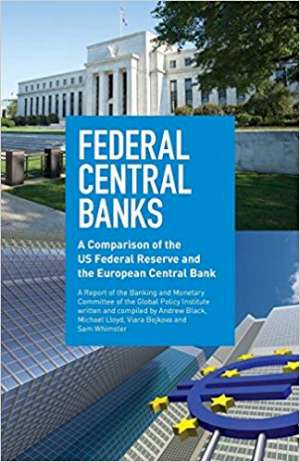25 March 2019
Federal Central Banks
A comparison of the US Federal Reserve and the European Central Bank
The Global Policy Institute
2018, The Global Policy Institute, 216 pages,
ISBN 9781907144103
Reviewer: James Smith, Director of Research, Resolution Foundation

Since the Global Financial crisis, monetary policy has famously become “ the only game in town2. As the role of central banks has expanded, the pressure on them has exposed the tension between the veneer of independence and the demands of democratic accountability. So transformed by the crisis is the role of central banks, it seems hard to remember when they were fully occupied with the now seemingly simple task of tweaking their policy rates to deliver stable inflation during the Great Moderation. For the European Central Bank (ECB), all this is magnified by the tug-of-war between collective and national interests.
This book plonks itself down right in the eye of this storm. It tackles the evolving role of central banks by comparing the world’s largest: the Fed and the ECB. In doing so, the aim of the game is to see what lessons can be drawn for the evolving policy framework in Europe. To manage expectations, it is worth acknowledging straight away that it is not meant as a gripping yarn. Instead it is a weighty, analytical report into these issues from the Global Policy Institute. And the reliance on secondary sources (acknowledged by the authors) means that some important issues are only partially explored. Nonetheless, it does provide a comprehensive assessment of where we are today and how we got here.
So how does this book do that? In short, it provides context and colour to the challenge of designing contemporary monetary policy frameworks. It does this by providing a readable summary of the evolution of the Fed, as well as the surprisingly deep-rooted origins of monetary union in Europe. It also sheds light on the impact of the crisis on both institutions, viewing this through the lens of the impact of their policies on regional and wealth inequality, which has amplified the pressure on both institutions. Finally, building on these insights, it provides some policy recommendations for the ECB.
The issue that permeates this book is the evolving nature of the monetary union in Europe. While the crisis has seen the role of the Fed expand considerably, that institution has had it easy compared to the ECB. While the US is clearly a mature federal system, the crisis has laid bare the tensions at the heart of the euro area. The most obvious of these is the lack of a single fiscal authority which can act to offset regional shocks. The support of fiscal policy was crucial in delivering a stronger recovery in the US than was seen in Europe.
At the heart of this is the all-too-familiar tension between the desire to keep control of policy at the national level, and the gains from acting in a coordinated and cooperative way across the euro area (an issue that is certainly not lost on ECB President Mario Draghi). All this was exacerbated during the euro-area crisis by relatively low levels of intra-European migration and the ‘doom loops’ faced by individual countries with debt problems.
This book is a comprehensive account of the key events leading to where we are today. The thorough telling of the backstory and the documentation of the frameworks under which each central bank operates will no doubt be useful for those working on these issues. The analytical tone to this book does mean that it lacks the flavour of more ‘fire-side’ accounts contained in some recent memoirs on the crisis (for example, the accounts of Yanis Varoufakis or Tim Geithner). That said, reading this book the overriding feeling with which you come away is gloominess about the future of European monetary union. While it’s hard to argue with the policy prescriptions given by the authors, it feels like there is much still to be done to deliver a stable and lasting monetary union. And what is striking from the account of how we got to where we are today is how much of the evolving frameworks of these major central banks was born out of crisis. All this points to the need to act sooner rather than later or, instead, face the possibility that things may get worse before they get better.
